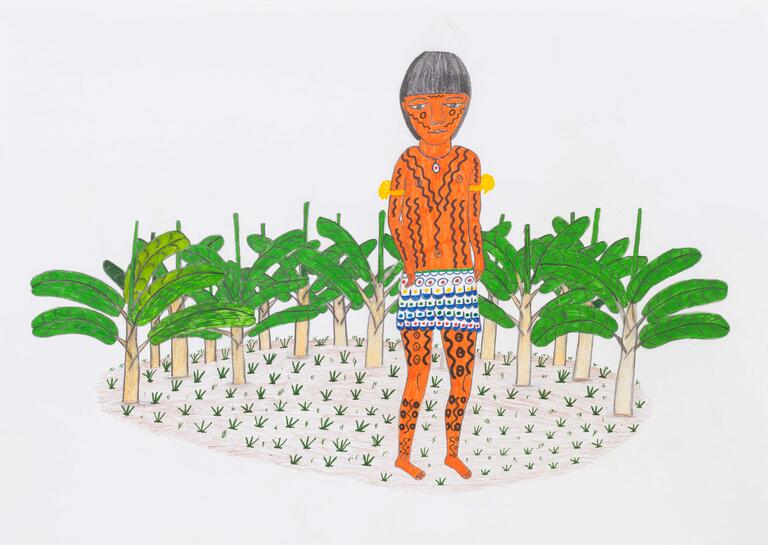
Joseca Yanomami: nossa terra-floresta [Our Land-Forest] Joseca Yanomami
The MASP – Museu de Arte de São Paulo Assis Chateaubriand and the Ministry of Tourism present, from July 29th to October 30th, 2022, the exhibition Joseca Yanomami: nossa terra-floresta [Our Land-Forest], at the first underground floor of the museum. Curated by Adriano Pedrosa, artistic director at MASP, and David Ribeiro, curatorial assistant at MASP, the exhibition brings together 93 drawings of characters, scenes, landscapes, and phenomena of the Yanomami universe, making reference to the forest, its people, its stories, and shamanic chants. This is the first solo exhibition dedicated to the artist's drawings, presenting an expressive part of his production in the same year of the celebration of the 30th anniversary of the ratification of the Yanomami Indigenous Territory. The show has the master sponsorship of Bradesco and sponsorship by Livelo.
Joseca Yanomami (1971, Uxi u river, Yanomami Indigenous Territory) is a visual artist from the Watoriki community, part of the Yanomami Indigenous Land in the Amazon. Interested in the realms of health and education, he founded the first Yanomami school of his group back in the 1990s, encouraging children to learn to write and study languages, a process he had recently experienced. At the time, he participated in the production of numerous bilingual brochures (Yanomami/Portuguese) destined for school and health education programs created by Brazilian NGOs. In the early 2000s, Joseca was the first Yanomami to work in the health field. Back then, he also began to carve in wood images of animals from the forest, and soon after began to dedicate himself to drawings that illustrated elements and stories of the Yanomami culture, daily life, context, and cosmology.
The exhibition gathers drawings from 2011 to 2013 about the Amazon forest-land and all beings that inhabit it, bringing various elements that make up the cosmology and daily life of its people and referring to the efforts of shamans, leaders, and spirits. "Joseca's drawings allow us, from our perspective and our way of feeling, to realize that the diversity that inhabits the forest also includes the xapiripë, the spirits that guarantee to all of us, indigenous and non-indigenous alike, the certainty that the Sun will rise tomorrow and that the sky will not fall on our heads," ponders curator David Ribeiro.
His productions seek to give body to the chants, dreams, and stories told by the shamans, a record that, beyond the artistic expression identified at first sight, gives color and shape to the spirits seen only by those who go through the process of becoming a spiritual leader. Most of the drawings are accompanied by descriptions originally made by the artist in Yanomami, which give an account of the cosmological dimensions present in his visual narrative. For instance, the work Urihi xi wãrii tëhë thë urihi huëmaɨ wihi thëã [The shamans hold the earth when it is in chaos], from 2011, is concerned with demonstrating the work of land preservation performed by the shamans, which adds to the environmental conservation carried out by indigenous and traditional peoples. "I didn't study in the city to learn how to draw, I studied only in the forest, where I hunted in the bushes. I would draw on the trees, on the beaches, I would draw on the coconut trees and on the young leaves, using charcoal. I would peel the tree and draw on the trunks. I draw my relatives, animals, trees, birds, macaws, monkeys, tapirs, fish. When I learned how to draw, I heard the pajés singing and I recorded it in my head to draw later. I draw the spirits. And when I dream, I study a lot, I think a lot about it, and I make many drawings of my dream," says Joseca Yanomami.
In the year in which the ratification of the Yanomami Indigenous Territory completes 30 years, the works of the artist also express the indigenous struggle against the threats that endanger the Yanomami and the forest-land they inhabit with all their visible and invisible beings, suggesting, even, the importance of non-indigenous people in this battle. "Joseca Yanomami's artistic production is a reminder of the part that concerns us, as non-indigenous people, in the defense of the rights of indigenous peoples and, by extension, the rights of the people of the forest," says David Ribeiro. "The arrival of these drawings at MASP is, therefore, the descent of the xapiripë to a territory that, in receiving them, assumes its commitment to the defense of the forest-land, of all those who inhabit it, and to the healing of the evils caused by the people of the merchandise to the people of the forest," he concludes.
The exhibition also includes the screening of the video SOPRO, by the Barreira Y collective, with support from the Fórum de Lideranças Yanomami e YeK'wana and the Instituto Socioambiental. The work features a projection of Joseca Yanomami's drawings, accompanied by speeches of Davi Kopenawa Yanomami, held in 2020 at the National Congress, as part of the campaign #foragarimpoforacovid, against mining activity and the dissemination of Covid-19, as well as other diseases and evils caused on the Yanomami land by miners.
Joseca Yanomami: Our Land-Forest is part of the biennial program of MASP dedicated to Brazilian Stories (2021-22), on the occasion of the bicentennial of the independence of Brazil' in 2022. This year, the program also includes exhibitions by Dalton Paula, Madalena dos Santos Reinbolt (1919-1977), Judith Lauand, and Cinthia Marcelle, in addition to Brazilian Stories, a major collective exhibition.